Description and Operation
Ignition timing is controlled by the electronic control ignition timing system.
The standard reference ignition timing data for the engine operating conditions
are pre-pro grammed in the memory of the ECM (Engine Control Module).
The engine operating conditions (speed, load, warm-up condition, etc.) are detected
by the various sensors. Based on these sensor signals and the ignition timing data,
signals to interrupt the primary current are sent to the ECM.
The ignition coil is activated, and timing is controlled.
Repair procedures
| Inspect ignition coil assembly and
Perform spark test |
| 1. |
Check for DTCs.
| •
|
If a DTC is present,
perform troubleshooting in accordance with the procedure
for that DTC. (Refer to DTC guide) |
|
|
| 2. |
Check if sparks occur.
| (1) |
Remove the engine cover. |
| (2) |
Remove the ignition coils. |
| (3) |
Using a spark plug wrench,
remove the spark plugs. |
| (4) |
Disconnect the injector
extension connectors. |
| (5) |
Ground the spark plug
to the engine.

|
| (6) |
Check if sparks occur
at each spark plug while engine is being cranked. |
| •
|
Do not crank
the engine for more then 5 seonds. |
|
|
| 3. |
If sparks do not occur, perform
the following test.
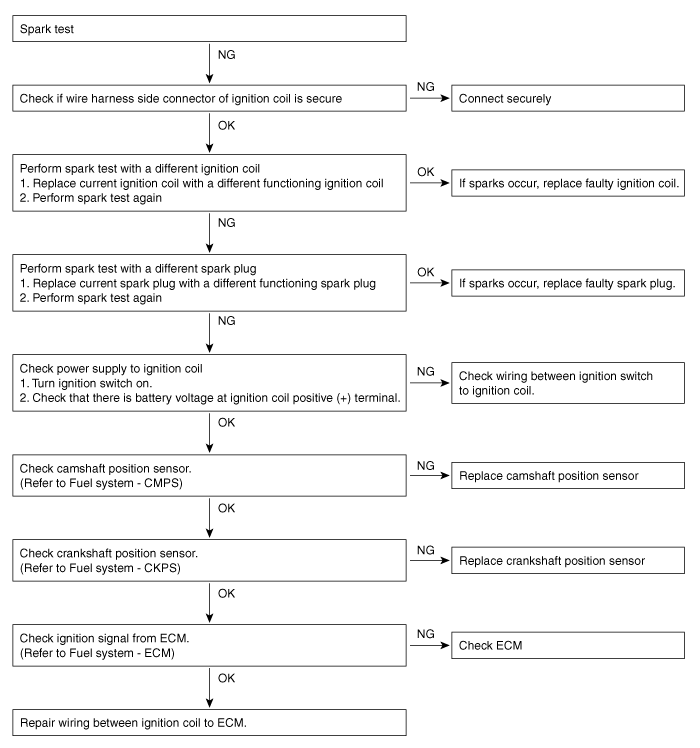
|
| 4. |
Using a spark plug wrench, install
spark plugs. |
| 5. |
Install the ignition coils.
|
| 6. |
Install the engine cover. |
Ignition Coil Description and Operation
An ignition coil is an induction coil in an engine's ignition system which transforms
the battery's low voltage to the high voltage needed to create an electric spark
in the spark plugs to ignite the fuel. Coils have an internal resistor while others
rely on a resistor wire or an external resistor to limit the current flowing into
the coil from the battery 12 V supply.
Ignition Coil Specifications
Item
|
Specification
|
Primary Coil Resistance (?)
|
0.61 ± 15% [20°C (68°F)]
|
Secondary Coil Resistance (k?)
|
7.5 ± 15% [20°C (68°F)]
|
Ignition Coil Schematic Diagrams

Ignition Coil Repair procedures
| 1. |
Turn ignition switch OFF and
disconnect the negative (-) battery cable. |
| 2. |
Remove the engine cover. |
| 3. |
Disconnect the ignition coil
connector (A).
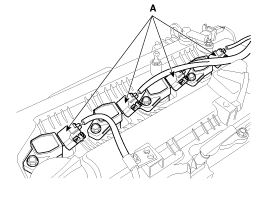
| •
|
When removing
the ignition coil connector, pull the lock pin (A) and push
the clip (B). |
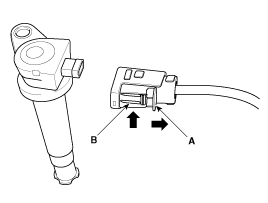
|
|
| 4. |
Remove the ignition coil (A).

|
| 1. |
Install in the reverse order
of removal.
Ignition coil installation
bolts:9.8 ~ 11.8 N.m (1.0 ~ 1.2 kgf.m, 7.2 ~ 8.7 Ib-ft)
|
|
| 1. |
Measure the primary coil resistance
between terminals 1 and 2.
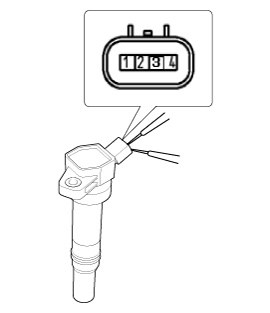
Standard value : 0.61 ? ±
15%
|
|
Spark Plug Description and Operation
A spark plug is a device for delivering electric current from an ignition system
to the combustion chamber of a spark-ignition engine to ignite the compressed fuel/air
mixture therein by means of an electric spark, while containing combustion pressure
within the engine. A spark plug has a metal threaded shell, electrically isolated
from a central electrode by a porcelain insulator.
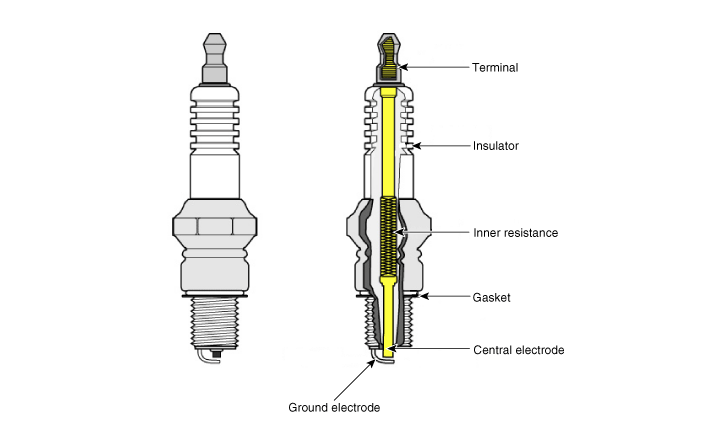
Spark Plug Specifications
Item
|
Specification
|
Type
|
ELR9IQP9+
|
Gap
|
0.8 ~ 0.9 mm (0.0314 ~ 0.0354 in.)
|
Spark Plug Repair procedures
| 1. |
Accelerate the engine to about
3,000 rpm 3 times or more. |
| 2. |
Remove the spark plug. |
| 3. |
Check the spark plug visually.
If the electrode is dry, the spark plug is normal.
If the electrode is wet, check the damage and electrode gap as below. |
| 1. |
Check the spark plug for any
damage on its thread and insulator. If there is damage, replace the spark
plug.
|
| 2. |
Check the electrode. Measure
the insulation resistance with an ohmmeter. If the resistance is less
than the specified value, adjust the electrode gap.
Specification: 10 M? or more
|
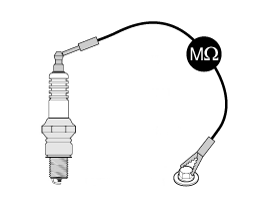
|
| 3. |
Check the spark plug electrode
gap. If the gap is greater than the maximum, replace the spark plug.
Specification: 0.8 ~ 0.9 mm
(0.0314 ~ 0.0354 in.)
|
| •
|
If adjusting
the gap of a new spark plug, bend only the base of the ground
electrode. Do not touch the tip. Never attempt to adjust
the gap on a used plug.
|
|
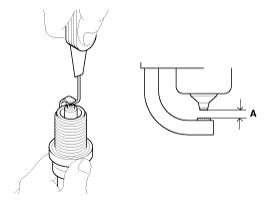
|
The combustion temporarily becomes unstable, due to the aged fuel and the carbon
deposits accumulated on the spark plug(s) after long-term storage.
| 1. |
Start the engine and keep the
engine running at idle for 2 minutes. |
| 2. |
Step on the accelerator pedal
and hold it steady at 4500 rpm with the shift lever in N position to warm
up the engine until the temperature of the engine coolant reaches
80°C. |
| 3. |
Keep the engine running at 2500~3000
rpm in the N position for 15 minutes.
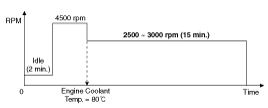
|
| • |
The 2nd method should
be performed only if the 1st method fails (the misfire-related codes
recur).
|
|
| 1. |
Start the engine and keep the
engine running at idle for 2 minutes. |
| 2. |
Drive the vehicle for over 20
minutes, keeping the engine speed above 3500 rpm.
| •
|
If equipped with
manual transaxle, shift the gear properly for keeping the
engine speed above 3500 rpm. |
|
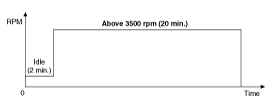
|
| 1. |
Remove the ignition coil.
(Refer to Ignition System - "Ignition Coil")
|
| 2. |
Using a spark plug wrench, remove
the spark plug (A).
| •
|
Be careful that
no contaminates enter into spark plug holes. |
|

|
| 1. |
Install in the reverse order
of removal.
Tightening torque:
14.7 ~ 24.5 N.m (1.5 ~ 2.5 kgf.m, 10.9 ~ 18.0 Ib-ft)
|
|
Specifications
Specification
Ignition System
Ignition Coil
Item
Specification
Primary Coil Resistance (?)
0.61 ± 15% [20°C (68°F)]
...
Components and Components Location
Components
ECM Battery
Alternator Starter
Instrument Cluster Ignition
switch or start/stop button
Battery sensor Hood switch
Descript ...
 Hyundai Elantra AD: Ignition System
Hyundai Elantra AD: Ignition System















